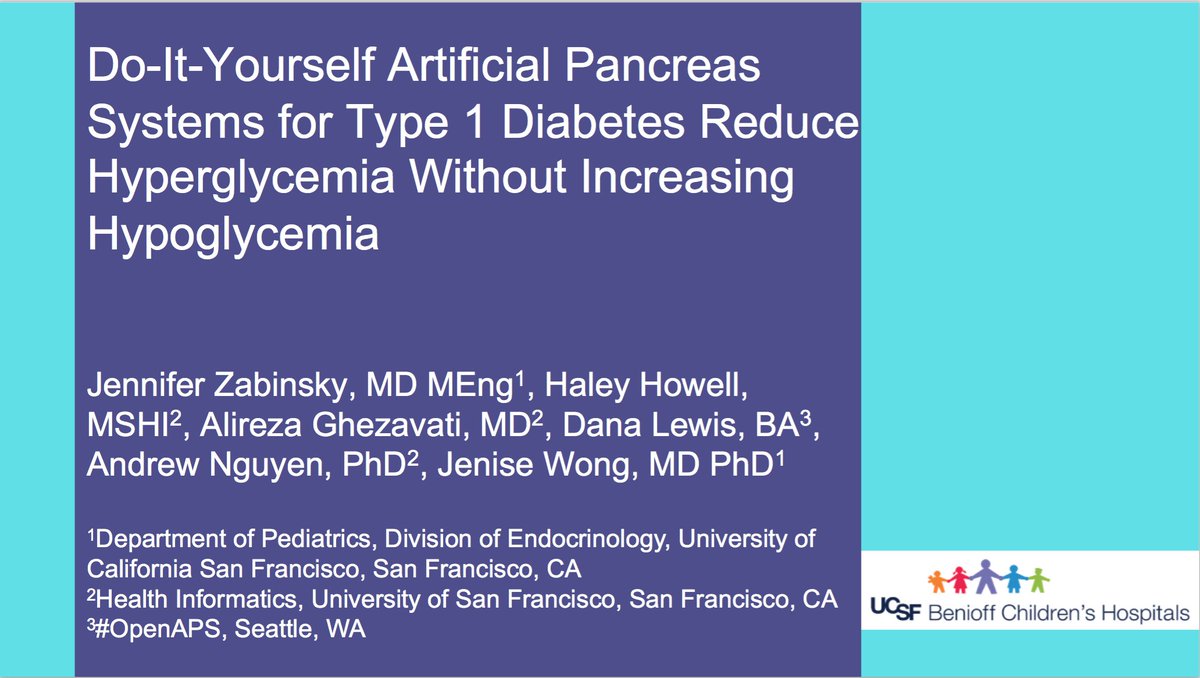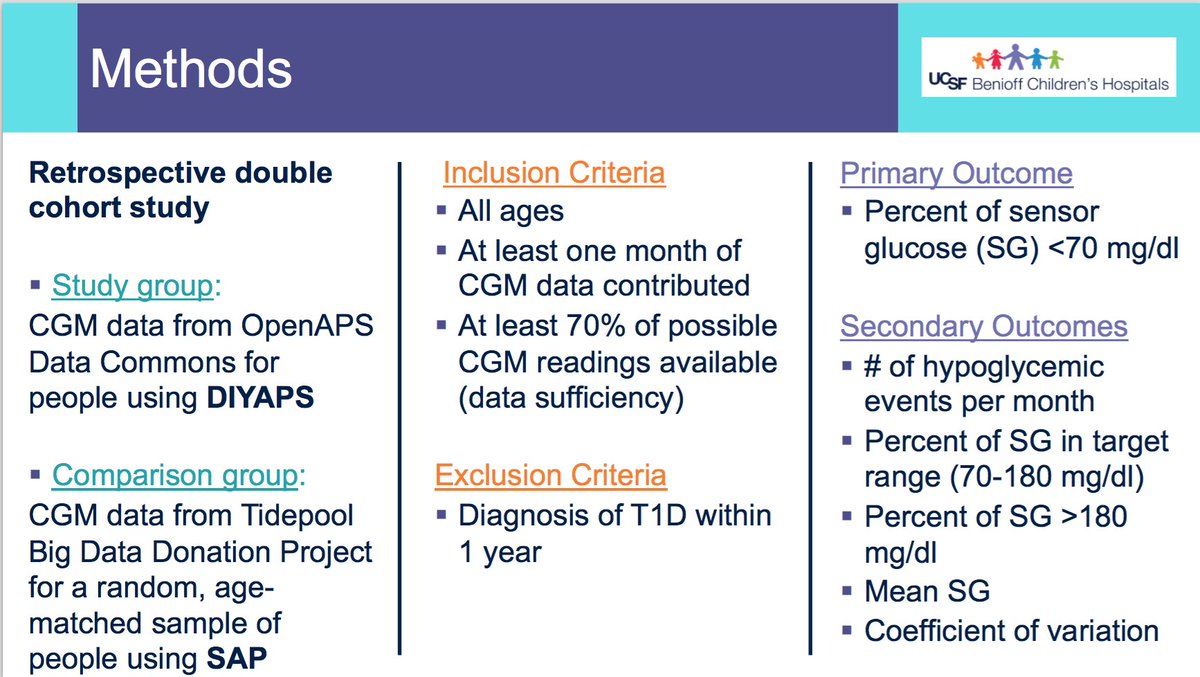Here is a Twitter thread from poster 117-LB at #ADA2019, DIWHY: Factors Influencing Motivation, Barriers and Duration of DIY Artificial Pancreas System Use Among Real-World Users. 

Background
Until recently, digital innovations in healthcare have typically followed a ‘top-down’ pathway, with manufacturers leading the design and production of technology-enabled solutions and patients involved only as users of the end-product. #ADA2019
Until recently, digital innovations in healthcare have typically followed a ‘top-down’ pathway, with manufacturers leading the design and production of technology-enabled solutions and patients involved only as users of the end-product. #ADA2019
This is being disrupted by increasing influence and popularity of more ‘bottom-up’ and patient-led open source initiatives. A primary example is growing movement of people with diabetes (PwD) who create their own “Do-it-Yourself” Artificial Pancreas Systems (DIY APS). #ADA2019
Objective
Little is known about why PwD leave traditional care pathways and turn to DIY technology. This study aims to examine the motivations of current DIYAPS users and their caregivers. #ADA2019
Little is known about why PwD leave traditional care pathways and turn to DIY technology. This study aims to examine the motivations of current DIYAPS users and their caregivers. #ADA2019
Research Design and Methods
An online survey with 34 items was distributed to DIYAPS users recruited through the Facebook groups “Looped” (and regional sub-groups) and Twitter pages of the “DOC” (Diabetes Online Community). #ADA2019
An online survey with 34 items was distributed to DIYAPS users recruited through the Facebook groups “Looped” (and regional sub-groups) and Twitter pages of the “DOC” (Diabetes Online Community). #ADA2019
Self-reported data was collected, managed and analyzed using the secure REDCap electronic data capture tools hosted at Charité - Universitaetsmedizin Berlin. #ADA2019
Results
1058 participants from 34 countries (81.3 % Europe, 14.7 % North America, 6.0 % Australia/WP, 3.1 % Asia, 0.1 % Africa), responded to the survey. #ADA2019
1058 participants from 34 countries (81.3 % Europe, 14.7 % North America, 6.0 % Australia/WP, 3.1 % Asia, 0.1 % Africa), responded to the survey. #ADA2019
The majority were adults (80.2 %) with type 1 diabetes (98.9 %) using a DIY APS themselves (43.0 % female, 56.8 % male, 0.3 % other) with a median age of 41 y and an average diabetes duration of 25.2y ±13.3. #ADA2019
19.8 % of the participants were parents and/or caregivers of children with type 1 diabetes (99.4 %) using a DIY APS (47.4 % female, 52.6 % male) with a median age of 10 y and an average diabetes duration of 5.1y ± 3.8. #ADA2019
People used various DIYAPS (58.2% AndroidAPS, 28.5% Loop, 18.8% OpenAPS, 5.7% other) on avg for duration of 10.1months ±17.6 & reported an overall HbA1c-improvement of -0.83% (7.07%±1.07 to 6.24%±0.68) & overall TIR improvement of +19.86% (63.21%±16.27 to 83.07%±10.11). #ADA2019
Participants indicated that DIYAPS use required them to pay out-of-pocket costs in addition to their standard healthcare expenses with an average amount of 712 USD spent per year. #ADA2019
Primary motivations for building a DIYAPS were to improve the overall glycaemic control, reduce acute and long-term complication risk, increase life expectancy and to put diabetes on ‘auto-pilot’ and interact less frequently with the system. #ADA2019 

Lack of commercially available closed loop systems & improvement of sleep quality was motivation for some. For caregivers, improvement of own sleep quality was leading motivation. For adults, curiosity (medical or technical interest) had higher impact on motivation. #ADA2019
Some people feel that commercial systems do not suit their individual needs and prefer to use a customizable system, which is only available to them as a DIY solution. #ADA2019
Other reasons, like costs of commercially available systems and unachieved therapy goals played a subordinate role. Lack of medical or psychosocial support was less likely to be motivating factors for both groups. #ADA2019
Conclusions
Our findings suggest that people using Do-it-Yourself Artificial Pancreas systems and their caregivers are highly motivated to improve their/their children’s diabetes management through the use of this novel technology. #ADA2019
Our findings suggest that people using Do-it-Yourself Artificial Pancreas systems and their caregivers are highly motivated to improve their/their children’s diabetes management through the use of this novel technology. #ADA2019
They are also able to access and afford the tools needed to use these systems. Currently approved and available commercial therapy options may not be sufficiently flexible or customizable enough to fulfill their individual needs. #ADA2019
As part of “OPEN”, results of this DIWHY survey may contribute to a better understanding of unmet needs of PwD & current challenges to uptake, which will, in turn, facilitate dialogue and collaboration to strengthen involvement of open source approaches in healthcare. #ADA2019
(You can find a longer form copy of this poster content, and all other posters co-authored by @danamlewis at bit.ly/DanaMLewisADA2…)
• • •
Missing some Tweet in this thread? You can try to
force a refresh










